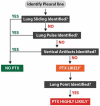Nuts and bolts of lung ultrasound: utility, scanning techniques, protocols, and findings in common pathologies
- PMID: 39375782
- PMCID: PMC11460009
- DOI: 10.1186/s13054-024-05102-y
Nuts and bolts of lung ultrasound: utility, scanning techniques, protocols, and findings in common pathologies
Abstract
Point of Care ultrasound (POCUS) of the lungs, also known as lung ultrasound (LUS), has emerged as a technique that allows for the diagnosis of many respiratory pathologies with greater accuracy and speed compared to conventional techniques such as chest x-ray and auscultation. The goal of this narrative review is to provide a simple and practical approach to LUS for critical care, pulmonary, and anesthesia providers, as well as respiratory therapists and other health care providers to be able to implement this technique into their clinical practice. In this review, we will discuss the basic physics of LUS, provide a hands-on scanning technique, describe LUS findings seen in normal and pathological conditions (such as mainstem intubation, pneumothorax, atelectasis, pneumonia, aspiration, COPD exacerbation, cardiogenic pulmonary edema, ARDS, and pleural effusion) and also review the training necessary to achieve competence in LUS.
Keywords: ARDS; Anesthesia; Aspiration; Atelectasis; COPD exacerbation; Cardiogenic pulmonary edema; Critical care; Critical care ultrasound; LUS; Lung ultrasound; Lung ultrasound training; Mainstem intubation; POCUS; POCUS competency; POCUS training; Pleural effusion; Pneumonia; Pneumothorax; Point of care ultrasound; Pulmonary; Ultrasound; Ultrasound competency; Ultrasound training.
© 2024. The Author(s).
Conflict of interest statement
None.
Figures





References
-
- Kendall JL, Hoffenberg SR, Smith RS. History of emergency and critical care ultrasound: the evolution of a new imaging paradigm. Crit Care Med. 2007. 10.1097/01.CCM.0000260623.38982.83. - PubMed
-
- Arnold MJ, Jonas CE, Carter RE. Point-of-care ultrasonography. Am Fam Physician. 2020;101(5):275–85. - PubMed
-
- Soldati G, Demi M, Smargiassi A, Inchingolo R, Demi L. The role of ultrasound lung artifacts in the diagnosis of respiratory diseases. Expert Rev Respir Med. 2019;13(2):163–72. 10.1080/17476348.2019.1565997. - PubMed
Publication types
MeSH terms
LinkOut - more resources
Full Text Sources

